Lord Krishna's lost city rediscoverd
- A LOST CITY RECOVERED -

Dwaraka was a western Indian city submerged by the sea right after the death of Sri Krishna. This was regarded as a grandiose metaphor, part of a story filled with great myths. But in the early eighties an important archaeological site was found at the site of the legendary city of Lord Krishna.
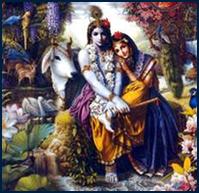
Situated in Saurashtra, at a point where the Gomti river meets the Arabian sea, it has acquired multifarious names down the ages: Dwaraka, the gateway to eternal happiness; Swarnapuri, the city of gold, Swarnadwarika, the golden gateway. Why is that the rediscovery of Dwaraka has not attracted the same degree of attention in the West, as that of ancient Troy by Heinrich Schliemann?
Literary texts like the Mahabharata, Harivamsha and Purana contain traditions about the foundation of Dwaraka, its planning and glory. Before the legendary city of Dwaraka was discovered some scholars were of the view that the Mahabharata being only a myth it would be futile to look for the remains of Dwaraka and that too in the sea. Others held that the Kurukshetra battle was a family feud exaggerated into a war.
Excavations done by Dr. S.R. Rao at Dwaraka prove that the descriptions as found in these texts are not to be discarded as fanciful but are to be treated as based on actualities as seen by their authors. The architecture of the old Dwaraka of Krishna is majestic and wonderful. The great poet Premanand has in his Sudamacarit described its splendid beauty and majesty. Dwaraka is mentioned as Golden City in Mahabharata, Skanda Purana, Vishnu Purana and Harivamsha.
Interesting descriptions about its construction are found in Purana. «Fearing attack from Jarasangh and Kalayvan on Mathura, Sri Krishna and Yadavas left Mathura and arrived at the coast of Saurashtra. They decided to build their capital in the coastal region and invoke the Vishwakarma, the deity of construction. However, Vishwakarma says that the task can be completed only if Samudradeva, the Lord of the sea provided some land. Sri Krishna worshipped Samudradeva, who was pleased and gave them land measuring 12 yojans and the divine architect Vishwakarma build Dwaraka, a city in gold». Another story says that at the time of the death of Sri Krishna, who was hit by the arrow of a hunter near Somnath at Bhalka Tirth, Dwaraka disappeared in the sea.
Literary texts like the Mahabharata, Harivamsha and Purana contain traditions about the foundation of Dwaraka, its planning and glory. Before the legendary city of Dwaraka was discovered some scholars were of the view that the Mahabharata being only a myth it would be futile to look for the remains of Dwaraka and that too in the sea. Others held that the Kurukshetra battle was a family feud exaggerated into a war.
Excavations done by Dr. S.R. Rao at Dwaraka prove that the descriptions as found in these texts are not to be discarded as fanciful but are to be treated as based on actualities as seen by their authors. The architecture of the old Dwaraka of Krishna is majestic and wonderful. The great poet Premanand has in his Sudamacarit described its splendid beauty and majesty. Dwaraka is mentioned as Golden City in Mahabharata, Skanda Purana, Vishnu Purana and Harivamsha.
Interesting descriptions about its construction are found in Purana. «Fearing attack from Jarasangh and Kalayvan on Mathura, Sri Krishna and Yadavas left Mathura and arrived at the coast of Saurashtra. They decided to build their capital in the coastal region and invoke the Vishwakarma, the deity of construction. However, Vishwakarma says that the task can be completed only if Samudradeva, the Lord of the sea provided some land. Sri Krishna worshipped Samudradeva, who was pleased and gave them land measuring 12 yojans and the divine architect Vishwakarma build Dwaraka, a city in gold». Another story says that at the time of the death of Sri Krishna, who was hit by the arrow of a hunter near Somnath at Bhalka Tirth, Dwaraka disappeared in the sea.

The information and material secured through underwater excavation of Dwaraka corroborates with the references to the city of Dwaraka, made in various Sanskrit literary works. In Mahabharata, there is a specific account about the submerging of Dwaraka by the sea, which reads thus: «The sea, which had been beating against the shores, suddenly broke the boundary that was imposed on it by nature. The sea rushed into the city. It coursed through the streets of the beautiful city. The sea covered up everything in the city. Even as they were all looking, Arjuna saw the beautiful buildings becoming submerged one by one. Arjuna took a last look at the mansion of Krishna. It was soon covered by the sea. In a matter of a few moments it was all over. The sea had now become as placid as a lake. There was no trace of the beautiful city which had been the favourite haunt of all the Pandavas. Dwaraka was just a name; just a memory».
The importance of the discovery of Dwaraka lies not merely in providing archaeological evidence needed for corroborating the traditional account of the submergence of Dwaraka but also indirectly fixing the date of the Mahabharata which is a landmark in Indian history. The Thermoluminiscence date of the pottery from Bet Dwaraka which is also connected with the Krishna legend is 3520 years Before Present. Identical pottery is found in the submerged city of Dwaraka. Thus the results have proved that the account in Mahabharata as to the existence of a beautiful capital city of Dwaraka of Sri Krishna was not a mere figment of imagination but it did exist.
The importance of the discovery of Dwaraka lies not merely in providing archaeological evidence needed for corroborating the traditional account of the submergence of Dwaraka but also indirectly fixing the date of the Mahabharata which is a landmark in Indian history. The Thermoluminiscence date of the pottery from Bet Dwaraka which is also connected with the Krishna legend is 3520 years Before Present. Identical pottery is found in the submerged city of Dwaraka. Thus the results have proved that the account in Mahabharata as to the existence of a beautiful capital city of Dwaraka of Sri Krishna was not a mere figment of imagination but it did exist.
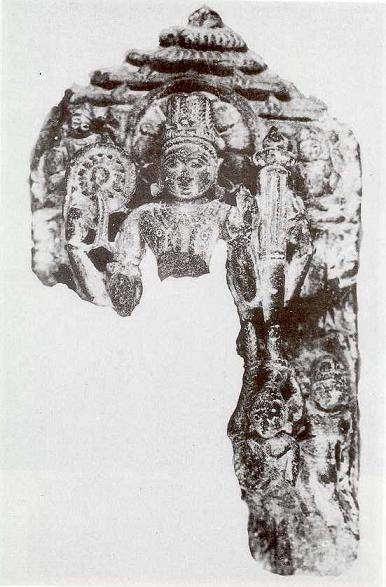
Besides the sea-ports, there were renowned cities which were washed away by the rivers on whose banks they were situated. We may cite here the case of Hastinapura and Pataliputra, situated on the bank of the river Ganga and falling victims to flood-fury. The Mahabharata mentions that Hastinapura was washed away by the Ganga and consequently the Pandavas had to migrate to Kaudambi. Pataliputra which was the premier city of the land (agranagara) and the test of the excellence of all the cities in the words of Dandin, the author of the Dashakumaracarita, later became the worst victim of inundation. The submerged parts of these cities are to be treated as protected monuments and great treasures of the ancient heritage of India. If Dwaraka excavations throw a flood of light on the history of the city which was associated with the life events of Krishna, the underwater excavations of Ayodhya situated on the bank of the river Sarayu might yield valuable information about the historicity of Rama, his age and contemporary urban status.
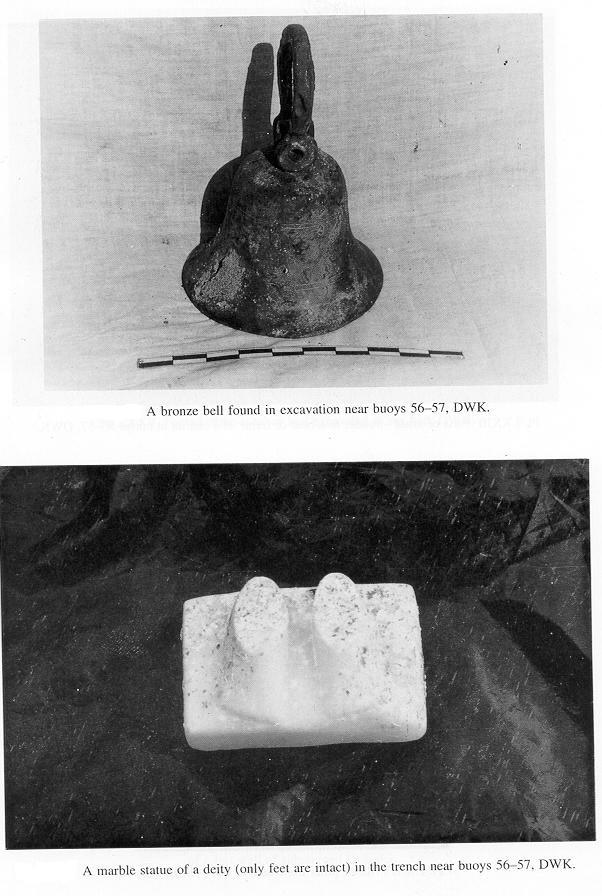
Since 1983 the Marine Archaeology Unit of the National Institute of Oceanography is engaged in the offshore exploration and excavation of the legendary city of Dwaraka in the coastal waters of Dwaraka in Gujarat. Brief accounts of the findings of the underwater search for the lost city have appeared in 1987, Progress and Prospects of Marine Archaeology in India, and in 1988, Marine Archaeology of Indian Ocean Countries.
A brief account of the discovery of the submerged city of Dwaraka of Mahabarata fame and the salient features of the structures exposed as a result of underwater excavation conducted at Dwaraka and Bet Dwaraka by the Marine Archaeology Unit of the National Institute of Oceanography under the direction of Dr. S.R. Rao from 1983 to 1987 appeared in 1988 (40 years of Research - A CSIR Overview). Offshore exploration of the legendary city at Dwaraka was resumed in 1988 and continued through 1990 (see the Journal of Marine Archaeology, 1990), further seaward of the Temple of Samudranardyana (Sea God) at Dwaraka with a view to trace the plan and extent of the port-city and the purpose of the massive stone walls built on the banks of ancient Gomati. It was also necessary to ascertain whether its architectural features were in conformation with the description of the city of Dwaraka given in the epic Mahabharata. A second object was to obtain more corroborative evidence for reclamation referred to in the epic. Thirdly, the nick point where the ancient Gomati river joined the sea had to be determined. Lastly, the cause of submergence of the city was another problem that needed further investigation.
Dwaraka was a city-state extending upto Bet Dwaraka (Sankhodhara) in the north and Okhamadhi in the south. Eastward it extended upto Pindara. The 30 to 40 meter-high hill on the eastern flank of Sankhodhara may be the Raivataka referred to in the Mahabharata. The general layout of the city of Dwaraka described in ancient texts agrees with that of the submerged city discovered. Four enclosures are laid bare; each one had one or two gateways. The port Aramda on way to Bet Dwaraka was the first gateway in the outer fortifications. The bastions flanking gateways of submerged Dwaraka resemble those of Kusinagara and Sravasti carved on the Gateways of Sanchi Stupa. The prasada referred to in the epic must be the high fort walls of Dwaraka, a part of which is extant. The epic says that flags were flying in the city of Dwaraka. This can be corroborated by the stone bases of flag posts found in the sea bed excavation. Umashankar Joshi is of the view that antardvipa in the region of Kugasthali referred to in the Mahabharata must be Bet Dwaraka. The Bhagavata Purana says that before leaving his mortal frame Sri Krishna put the ladies and children in boats and sent them to Sankhodhara.
The buildings built of smaller fraction stone blocks are razed to the ground leaving only small portions of the thick fort walls, bastions and protection walls (built with massive stones) which are too heavy to be moved by tides and currents. From the structural remains in Dwaraka and Bet Dwaraka waters, it is possible to visualise that the city-ports were large and well planned.
Every significant antiquity that corroborates a statement of the Harivamsa is the seal bearing the motif of a three-headed animal representing the bull, unicorn and goat. The Harivamsha says that every citizen of Dwaraka had to carry a mudra as a mark of identifications The seal (mudra) found in the excavation belongs to 15th-16th century B.C.
Nearly two decades after marine archeologists found the lost city of Dwaraka off the coast of Gujarat the state government continues to drag its feet on a proposal to establish the world's first underwater museum to view the remains of the city submerged in the Arabian Sea.
A brief account of the discovery of the submerged city of Dwaraka of Mahabarata fame and the salient features of the structures exposed as a result of underwater excavation conducted at Dwaraka and Bet Dwaraka by the Marine Archaeology Unit of the National Institute of Oceanography under the direction of Dr. S.R. Rao from 1983 to 1987 appeared in 1988 (40 years of Research - A CSIR Overview). Offshore exploration of the legendary city at Dwaraka was resumed in 1988 and continued through 1990 (see the Journal of Marine Archaeology, 1990), further seaward of the Temple of Samudranardyana (Sea God) at Dwaraka with a view to trace the plan and extent of the port-city and the purpose of the massive stone walls built on the banks of ancient Gomati. It was also necessary to ascertain whether its architectural features were in conformation with the description of the city of Dwaraka given in the epic Mahabharata. A second object was to obtain more corroborative evidence for reclamation referred to in the epic. Thirdly, the nick point where the ancient Gomati river joined the sea had to be determined. Lastly, the cause of submergence of the city was another problem that needed further investigation.
Dwaraka was a city-state extending upto Bet Dwaraka (Sankhodhara) in the north and Okhamadhi in the south. Eastward it extended upto Pindara. The 30 to 40 meter-high hill on the eastern flank of Sankhodhara may be the Raivataka referred to in the Mahabharata. The general layout of the city of Dwaraka described in ancient texts agrees with that of the submerged city discovered. Four enclosures are laid bare; each one had one or two gateways. The port Aramda on way to Bet Dwaraka was the first gateway in the outer fortifications. The bastions flanking gateways of submerged Dwaraka resemble those of Kusinagara and Sravasti carved on the Gateways of Sanchi Stupa. The prasada referred to in the epic must be the high fort walls of Dwaraka, a part of which is extant. The epic says that flags were flying in the city of Dwaraka. This can be corroborated by the stone bases of flag posts found in the sea bed excavation. Umashankar Joshi is of the view that antardvipa in the region of Kugasthali referred to in the Mahabharata must be Bet Dwaraka. The Bhagavata Purana says that before leaving his mortal frame Sri Krishna put the ladies and children in boats and sent them to Sankhodhara.
The buildings built of smaller fraction stone blocks are razed to the ground leaving only small portions of the thick fort walls, bastions and protection walls (built with massive stones) which are too heavy to be moved by tides and currents. From the structural remains in Dwaraka and Bet Dwaraka waters, it is possible to visualise that the city-ports were large and well planned.
Every significant antiquity that corroborates a statement of the Harivamsa is the seal bearing the motif of a three-headed animal representing the bull, unicorn and goat. The Harivamsha says that every citizen of Dwaraka had to carry a mudra as a mark of identifications The seal (mudra) found in the excavation belongs to 15th-16th century B.C.
Nearly two decades after marine archeologists found the lost city of Dwaraka off the coast of Gujarat the state government continues to drag its feet on a proposal to establish the world's first underwater museum to view the remains of the city submerged in the Arabian Sea.
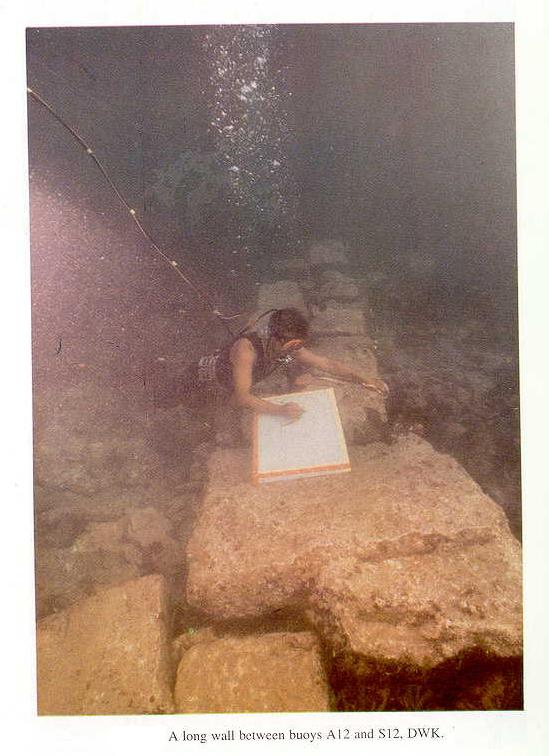
The proposal for the museum, submitted by the Marine Archeology Center of the National Institute of Oceanography in Goa, involves laying a submarine acrylic tube through which visitors can view through glass windows the ruins of the city said to have been be ruled by Sri Krishna, 3500 years ago.
Discovered in 1981, the well-fortified township of Dwaraka extended more than half a mile from the shore and was built in six sectors along the banks of a river before it became submerged. The findings are of immense cultural importance to India.
«The search for the lost city has been going on since 1930» — S.R. Rao, who is still actively involved in the excavations, told India Abroad. «It is only after marine archaeologists started exploring the sea-bed near modem Dwaraka from 1981 that the structural remains of the city were found».
Rao said that if a fraction of the funds spent on land archeology were made available for underwater archaeology, more light could be thrown on Dwaraka, which had much archeological significance because it was built during the second urbanization that occurred in India after the Indus Valley civilization in northwestern India. Dwaraka’s existence disproves the belief held by Western archeologists that there was no urbanization in the Indian subcontinent from the period between 1700 BC. (Indus Valley) and 550 BC. (advent of Buddhism). As no information was available about that period, they had labeled it the Dark Period.
«The findings in Dwaraka and archeological evidence found compatible with the Mahabharata tradition remove the lingering doubt about the historicity of the great epic. We would say Krishna definitely existed», said Rao. What is needed, he added, is the political will to reconstruct the cultural history of the Vedic and epic periods of northern India.
Over 200 experts from 84 countries, who gathered under the aegis of UNESCO in Paris recently to examine a draft convention on the issue, unanimously agreed that underwater cultural heritage was in urgent need of protection from destruction and pillaging.
In Dwaraka, Krishna is supposed to have built a mighty kingdom on a site selected for him by Vishnu’s learned ‘vahan’, Garud. The city he built is supposed to have extended over 104 kms. It was well fortified and surrounded by a moat, spanned by bridges, which were removed in the event of attack by an enemy.
Archaeological excavations have unearthed artifacts that prove that modern Dwaraka is the sixth settlement of the name on this site. The earlier cities have been, at various times, swallowed by the sea. The waves of the sea still lap the shores of this famous town, lending scenic beauty to this important pilgrimage destination.
The Dwarkadhish temple, dedicated to Sri Krishna, is the focal point of all pilgrimages. Parts of it date from the 12th-13th century and others from the 16th, but the Jag Mandir, its sanctum sanctorum, is supposed to be 2,500 years old. The hall in front is richly carved and supported by 60 massive pillars, each one hewn out of a single stone slab. Many of the sculptures date from the Maurya, Gupta and Chalukya periods. Some of the subjects are of Jaina and Buddhist origin. The temple is 157 feet high.
Another important pilgrimage site in the ancient city of Dwarka is Gomti ghat. The myth attached to the original temple says that it was built overnight at the instructions of Vajranabh, the great-grandson of Krishna, by the divine craftsman Vishvakarma. Archaeologists are undecided about the date of construction of the temple that exists now, but it is generally believed that it was rebuilt in the 10th or 11th century AD after the original temple was destroyed, probably during the Muslim invasions.
Most of the temples and pilgrimage spots around Dwaraka are associated with Krishna and the Vaishnavite tradition. However, the temple of Somnath, which is not very far from this place, is dedicated to Shiva as Nagnath or Nageshwar Mahadev, and enshrines one of the twelve ‘Jyotirlinga’ which according to the Purana manifested themselves as columns of light in different parts of the country. The magnificent temple that stands there now is a replica of the original temple.
An archaeological site, dating back to 7500 BC and older than hitherto oldest known human civilisations including those found in the Valley of Sumer, Harappa and Egypt, was discovered by a team of Indian marine archaeologists in the Gulf of Cambay off Gujarat coast. «For India, it was the first time that such an important discovery was reported from near Dwaraka site, the off-shore region where underwater archeological exploration was in progress», Union Minister for Science and Technology Murli Manohar Joshi said at a crowded Press conference.
«Further investigation of this area was important as it might throw some light on the development of human civilisation, besides having a bearing on the Indian history», concluded Dr. Joshi.
Discovered in 1981, the well-fortified township of Dwaraka extended more than half a mile from the shore and was built in six sectors along the banks of a river before it became submerged. The findings are of immense cultural importance to India.
«The search for the lost city has been going on since 1930» — S.R. Rao, who is still actively involved in the excavations, told India Abroad. «It is only after marine archaeologists started exploring the sea-bed near modem Dwaraka from 1981 that the structural remains of the city were found».
Rao said that if a fraction of the funds spent on land archeology were made available for underwater archaeology, more light could be thrown on Dwaraka, which had much archeological significance because it was built during the second urbanization that occurred in India after the Indus Valley civilization in northwestern India. Dwaraka’s existence disproves the belief held by Western archeologists that there was no urbanization in the Indian subcontinent from the period between 1700 BC. (Indus Valley) and 550 BC. (advent of Buddhism). As no information was available about that period, they had labeled it the Dark Period.
«The findings in Dwaraka and archeological evidence found compatible with the Mahabharata tradition remove the lingering doubt about the historicity of the great epic. We would say Krishna definitely existed», said Rao. What is needed, he added, is the political will to reconstruct the cultural history of the Vedic and epic periods of northern India.
Over 200 experts from 84 countries, who gathered under the aegis of UNESCO in Paris recently to examine a draft convention on the issue, unanimously agreed that underwater cultural heritage was in urgent need of protection from destruction and pillaging.
In Dwaraka, Krishna is supposed to have built a mighty kingdom on a site selected for him by Vishnu’s learned ‘vahan’, Garud. The city he built is supposed to have extended over 104 kms. It was well fortified and surrounded by a moat, spanned by bridges, which were removed in the event of attack by an enemy.
Archaeological excavations have unearthed artifacts that prove that modern Dwaraka is the sixth settlement of the name on this site. The earlier cities have been, at various times, swallowed by the sea. The waves of the sea still lap the shores of this famous town, lending scenic beauty to this important pilgrimage destination.
The Dwarkadhish temple, dedicated to Sri Krishna, is the focal point of all pilgrimages. Parts of it date from the 12th-13th century and others from the 16th, but the Jag Mandir, its sanctum sanctorum, is supposed to be 2,500 years old. The hall in front is richly carved and supported by 60 massive pillars, each one hewn out of a single stone slab. Many of the sculptures date from the Maurya, Gupta and Chalukya periods. Some of the subjects are of Jaina and Buddhist origin. The temple is 157 feet high.
Another important pilgrimage site in the ancient city of Dwarka is Gomti ghat. The myth attached to the original temple says that it was built overnight at the instructions of Vajranabh, the great-grandson of Krishna, by the divine craftsman Vishvakarma. Archaeologists are undecided about the date of construction of the temple that exists now, but it is generally believed that it was rebuilt in the 10th or 11th century AD after the original temple was destroyed, probably during the Muslim invasions.
Most of the temples and pilgrimage spots around Dwaraka are associated with Krishna and the Vaishnavite tradition. However, the temple of Somnath, which is not very far from this place, is dedicated to Shiva as Nagnath or Nageshwar Mahadev, and enshrines one of the twelve ‘Jyotirlinga’ which according to the Purana manifested themselves as columns of light in different parts of the country. The magnificent temple that stands there now is a replica of the original temple.
An archaeological site, dating back to 7500 BC and older than hitherto oldest known human civilisations including those found in the Valley of Sumer, Harappa and Egypt, was discovered by a team of Indian marine archaeologists in the Gulf of Cambay off Gujarat coast. «For India, it was the first time that such an important discovery was reported from near Dwaraka site, the off-shore region where underwater archeological exploration was in progress», Union Minister for Science and Technology Murli Manohar Joshi said at a crowded Press conference.
«Further investigation of this area was important as it might throw some light on the development of human civilisation, besides having a bearing on the Indian history», concluded Dr. Joshi.
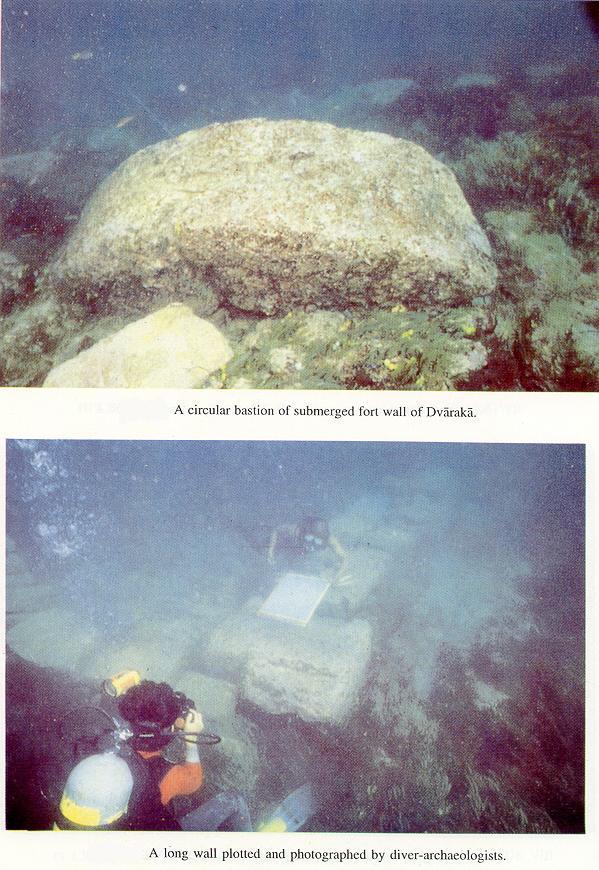
In order to establish without any doubt wheter or not the ruins on the seabed are effectively of the city of Dwarka, a group of archaeological experts and Indian Navy divers are conducting a scientific survey off the Gujarat coast.
«We found building blocks and collected samples. These have been sent for dating to establish the antiquity of the site,» Alok Tripathi of the Archaeological Survey of India (ASI) told, who is the ASI’s only marine archaeologist.
A 21-member team conducted the survey in January-February 2007. It comprised 10 specialists from the ASI and 11 divers of the Indian Navy.
«While the ASI has the requisite data and archaeological expertise, the Indian Navy has the necessary wherewithal and expertise for subsurface search, exploration and recovery of artefacts,» Rear Admiral, S.P.S. Cheema, assistant chief of naval staff, explained. «Before the excavation, naval divers were indoctrinated by ASI experts on the procedures and method to be followed during the investigation. These included aspects like documentation, controlled digging, and the retrieval, packaging and transportation of samples» Cheema said. «The idea was to achieve maximum extraction without damaging the environment,» he added.
Before commencing diving operations, a specialised naval hydrographic team systematically surveyed the area off Dwarka with the help of multi-beam sonar and side-scan sonar. The navy had deployed its survey ship INS Nirdeshak for this in November 2006.
«This enabled us generate a 3D model of the seabed so we could narrow down the area of search. We initially marked out a 200 metre by 200 metre area and eventually narrowed this down to 50x50 metre area,» Tripathi explained.
( Text and pictures courtesy : http://www.arianuova.org/arianuova.it/arianuova.it/Components/English/A12-Dwaraka.html
«We found building blocks and collected samples. These have been sent for dating to establish the antiquity of the site,» Alok Tripathi of the Archaeological Survey of India (ASI) told, who is the ASI’s only marine archaeologist.
A 21-member team conducted the survey in January-February 2007. It comprised 10 specialists from the ASI and 11 divers of the Indian Navy.
«While the ASI has the requisite data and archaeological expertise, the Indian Navy has the necessary wherewithal and expertise for subsurface search, exploration and recovery of artefacts,» Rear Admiral, S.P.S. Cheema, assistant chief of naval staff, explained. «Before the excavation, naval divers were indoctrinated by ASI experts on the procedures and method to be followed during the investigation. These included aspects like documentation, controlled digging, and the retrieval, packaging and transportation of samples» Cheema said. «The idea was to achieve maximum extraction without damaging the environment,» he added.
Before commencing diving operations, a specialised naval hydrographic team systematically surveyed the area off Dwarka with the help of multi-beam sonar and side-scan sonar. The navy had deployed its survey ship INS Nirdeshak for this in November 2006.
«This enabled us generate a 3D model of the seabed so we could narrow down the area of search. We initially marked out a 200 metre by 200 metre area and eventually narrowed this down to 50x50 metre area,» Tripathi explained.
( Text and pictures courtesy : http://www.arianuova.org/arianuova.it/arianuova.it/Components/English/A12-Dwaraka.html


Comments